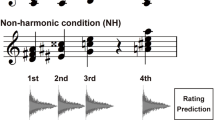Few studies have been reported on the effects of music on brain biopotentials. The present investigation addresses the perception of consonant and dissonant chords by humans. Subjectively presented consonant intervals were evaluated as more harmonic and pleasant than dissonant intervals. Analysis of evoked brain activity showed that the perception of dissonant chords was accompanied by activation of the right frontal lobe, which regulates negative emotions, while consonant chords activated the left frontal area, which regulates positive emotions.
Similar content being viewed by others
References
L. I. Aftanas, A. A. Varlamov, S. V. Pavlov, et al., “Reflection of the signs of emotions in the effects of evoked EEG synchronization and desynchronization,” Ros. Fiziol. Zh., 88, No. 6, 790–802 (2002).
A. L. Gotsdiner, Musical Psychology [in Russian], MIP Magistr, Moscow (1993), pp. 38–96.
V. P. Morozov, The Wonders of Bioacoustics. Stories of the Language of Emotions in the Animal and Human World [in Russian], Nauka, Moscow (1983), pp. 51–52.
P. V. Simonov, “Functional asymmetry of the frontal neocortex and emotions,” Dokl. Ros. Akad. Nauk., 338, No. 5, 689–692 (1994).
V. B. Strelets, “Mapping of brain biopotentials in emotional and cognitive pathology,” Zh. Vyssh. Nerv. Deyat., 47, No. 2, 226–242 (1997).
L. I. Aftanas and S. A. Golocheikine, “Human anterior and frontal midline theta and lower alpha reflect emotionally positive state and internalized attention: high-resolution EEG investigation of meditation,” Neurosci. Lett., 310, No. 1, 57–60 (2001).
E. Basar, M. Schurmann, and O. Sakowitz, “The selectively distributed theta system: functions,” Int. J. Psychophysiol., 39, 197–212 (2001).
R. J. Davidson, D. C. Jackson, and N. H. Nalin, “Emotion, plasticity, context, and regulation: perspectives from affective neuroscience,” Psychol. Bull., 126, 890–909 (2000).
K. Inanaga, “Frontal midline theta rhythm and mental activity,” Psychiatry Clin. Neurosci., 52, 555–566 (1998).
K. Itoh, S. Suwazono, and T. Nakada, “Central auditory processing of noncontextual consonance in music: an evoked potential study,” J. Acoust. Soc. Am., 128, No. 6, 3781–3787 (2010).
K. Itoh, S. Suwasono, and T. Nakada, “Central auditory processing of noncontextual consonance in music: an evoked potential study,” J. Acoust. Soc. Am., 128, No. 6, 3781–3787 (2010).
I. Fishman and O. Volkov, “Consonance and dissonance of musical chord: neural; correlates in auditory cortex of monkeys and humans,” J. Neurophysiol., 86, 2761–2788 (2001).
E. E. Hannon and S. E. Trehub, “Turning into musical rhythms: infants learn more readily than adults,” Proc. Natl. Acad. Sci. USA, 102, 12639–12643 (2005).
W. Heller, “Neuropsychological mechanisms of individual differences in emotion, personality, and arousal,” Neuropsychology, 7, 476–489 (1993).
W. Klimesch, “EEG alpha and theta oscillations reflect cognitive and memory performance: a review and analysis,” Brain Res. Rev., 29, 169–195 (1999).
E. Kushnerenko, I. Winkler, J. Horvath, et al., “Processing acoustic change and novelty in newborn infants,” Eur. J. Neurosci., 26, 265–274 (2007).
K. Lee and E. Skoe, “Selective subcortical enhancement of musical intervals in musicians,” J. Neurosci., 29, No. 18, 5832–3840 (2009).
J. Y. Park, H. Park, and J. Kim, “Consonant chords stimulate higher EEG gamma activity than dissonant chords,” Neurosci. Lett., 488, No. 1, 101–105 (2011).
N. Passynkova, H. Neubauer, and H. Scheich, “Spatial organization of EEG coherence during listening to consonant and dissonant chords,” Neurosci. Lett., 412, neuron 1, 6–11 (2007).
G. Pfurtscheller and F. H. Lopes DC Silva, “Event-related EEG/EMG synchronization and desynchronization. Basic principles,” Clin. Neurophysiol., 110, 1842–1857 (1999).
Author information
Authors and Affiliations
Corresponding author
Additional information
Translated from Zhurnal Vysshei Nervnoi Deyatel”nosti imeni I. P. Pavlova, Vol. 62, No. 3, pp. 286–291, May–June, 2012.
Rights and permissions
About this article
Cite this article
Maslennikova, A.V., Varlamov, A.A. & Strelets, V.B. Evoked Changes in EEG Band Power on Perception of Consonant and Dissonant Chords. Neurosci Behav Physi 43, 670–673 (2013). https://doi.org/10.1007/s11055-013-9790-4
Received:
Accepted:
Published:
Issue Date:
DOI: https://doi.org/10.1007/s11055-013-9790-4




